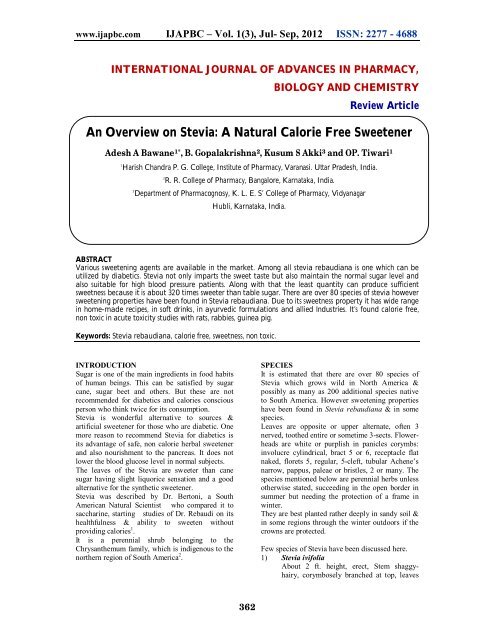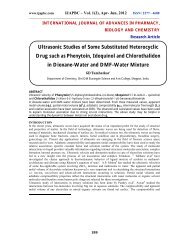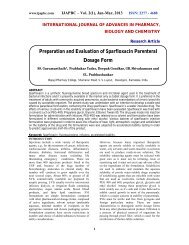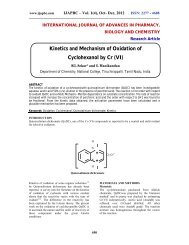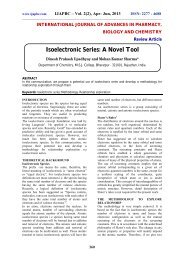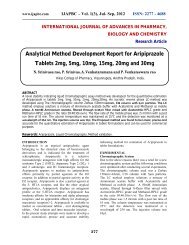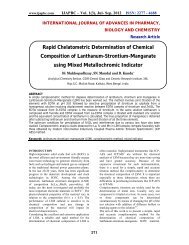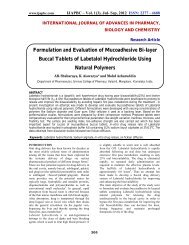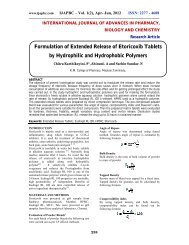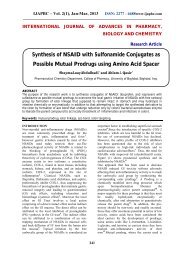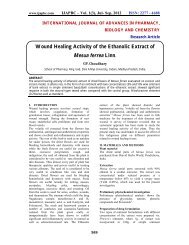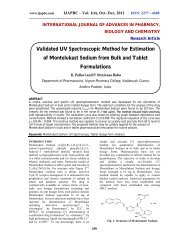An Overview on Stevia: A Natural Calorie Free Sweetener - ijapbc
An Overview on Stevia: A Natural Calorie Free Sweetener - ijapbc
An Overview on Stevia: A Natural Calorie Free Sweetener - ijapbc
You also want an ePaper? Increase the reach of your titles
YUMPU automatically turns print PDFs into web optimized ePapers that Google loves.
www.<strong>ijapbc</strong>.com IJAPBC – Vol. 1(3), Jul- Sep, 2012 ISSN: 2277 - 4688<br />
INTERNATIONAL JOURNAL OF ADVANCES IN PHARMACY,<br />
BIOLOGY AND CHEMISTRY<br />
Review Article<br />
<str<strong>on</strong>g>An</str<strong>on</strong>g> <str<strong>on</strong>g>Overview</str<strong>on</strong>g> <strong>on</strong> <strong>Stevia</strong>: A <strong>Natural</strong> <strong>Calorie</strong> <strong>Free</strong> <strong>Sweetener</strong><br />
Adesh A Bawane 1* , B. Gopalakrishna 2 , Kusum S Akki 3 and OP. Tiwari 1<br />
1<br />
Harish Chandra P. G. College, Institute of Pharmacy, Varanasi. Uttar Pradesh, India.<br />
2<br />
R. R. College of Pharmacy, Bangalore, Karnataka, India.<br />
3<br />
Department of Pharmacognosy, K. L. E. S’ College of Pharmacy, Vidyanagar<br />
Hubli, Karnataka, India.<br />
ABSTRACT<br />
Various sweetening agents are available in the market. Am<strong>on</strong>g all stevia rebaudiana is <strong>on</strong>e which can be<br />
utilized by diabetics. <strong>Stevia</strong> not <strong>on</strong>ly imparts the sweet taste but also maintain the normal sugar level and<br />
also suitable for high blood pressure patients. Al<strong>on</strong>g with that the least quantity can produce sufficient<br />
sweetness because it is about 320 times sweeter than table sugar. There are over 80 species of stevia however<br />
sweetening properties have been found in <strong>Stevia</strong> rebaudiana. Due to its sweetness property it has wide range<br />
in home-made recipes, in soft drinks, in ayurvedic formulati<strong>on</strong>s and allied Industries. It’s found calorie free,<br />
n<strong>on</strong> toxic in acute toxicity studies with rats, rabbies, guinea pig.<br />
Keywords: <strong>Stevia</strong> rebaudiana, calorie free, sweetness, n<strong>on</strong> toxic.<br />
INTRODUCTION<br />
Sugar is <strong>on</strong>e of the main ingredients in food habits<br />
of human beings. This can be satisfied by sugar<br />
cane, sugar beet and others. But these are not<br />
recommended for diabetics and calories c<strong>on</strong>scious<br />
pers<strong>on</strong> who think twice for its c<strong>on</strong>sumpti<strong>on</strong>.<br />
<strong>Stevia</strong> is w<strong>on</strong>derful alternative to sources &<br />
artificial sweetener for those who are diabetic. One<br />
more reas<strong>on</strong> to recommend <strong>Stevia</strong> for diabetics is<br />
its advantage of safe, n<strong>on</strong> calorie herbal sweetener<br />
and also nourishment to the pancreas. It does not<br />
lower the blood glucose level in normal subjects.<br />
The leaves of the <strong>Stevia</strong> are sweeter than cane<br />
sugar having slight liquorice sensati<strong>on</strong> and a good<br />
alternative for the synthetic sweetener.<br />
<strong>Stevia</strong> was described by Dr. Bert<strong>on</strong>i, a South<br />
American <strong>Natural</strong> Scientist who compared it to<br />
saccharine, starting studies of Dr. Rebaudi <strong>on</strong> its<br />
healthfulness & ability to sweeten without<br />
providing calories 1 .<br />
It is a perennial shrub bel<strong>on</strong>ging to the<br />
Chrysanthemum family, which is indigenous to the<br />
northern regi<strong>on</strong> of South America 2 .<br />
SPECIES<br />
It is estimated that there are over 80 species of<br />
<strong>Stevia</strong> which grows wild in North America &<br />
possibly as many as 200 additi<strong>on</strong>al species native<br />
to South America. However sweetening properties<br />
have been found in <strong>Stevia</strong> rebaudiana & in some<br />
species.<br />
Leaves are opposite or upper alternate, often 3<br />
nerved, toothed entire or sometime 3-sects. Flowerheads<br />
are white or purplish in panicles corymbs:<br />
involucre cylindrical, bract 5 or 6, receptacle flat<br />
naked, florets 5, regular, 5-cleft, tubular Achene’s<br />
narrow, pappus, paleae or bristles, 2 or many. The<br />
species menti<strong>on</strong>ed below are perennial herbs unless<br />
otherwise stated, succeeding in the open border in<br />
summer but needing the protecti<strong>on</strong> of a frame in<br />
winter.<br />
They are best planted rather deeply in sandy soil &<br />
in some regi<strong>on</strong>s through the winter outdoors if the<br />
crowns are protected.<br />
Few species of <strong>Stevia</strong> have been discussed here.<br />
1) <strong>Stevia</strong> ivifolia<br />
About 2 ft. height, erect, Stem shaggyhairy,<br />
corymbosely branched at top, leaves<br />
362
homboid-lanceolate, deeply sharply<br />
toothed, upper sessile. Flower heads white,<br />
in fastigiated corymbs; involucre & florets<br />
glandular & downy.<br />
2) <strong>Stevia</strong> ovata<br />
About 2 ft. height, Stem erect, Leaves ovate,<br />
toothed, wedge shaped at base; upper<br />
obl<strong>on</strong>g, sub entire, flower-heads white, in<br />
rather compact fastigiated corymbs.<br />
3) <strong>Stevia</strong> purpurea<br />
About 18 inch height, erect stem velvery<br />
hairy much branched. Leaves lanceolate,<br />
alternate, lower obovate, channeled,<br />
narrowed to stalk, toothed at apex. Flowerheads<br />
purple in some what fastigiated<br />
corymbs, involucre pale greenish.<br />
4) <strong>Stevia</strong> rebaudiana<br />
<str<strong>on</strong>g>An</str<strong>on</strong>g>nual herb, 1- 1½ feet height stem<br />
puberulous leaves opposite, oblanceolate,<br />
crenulate flower heads very small, whitish in<br />
a corymb Leaves have a sugary flavour.<br />
Syn<strong>on</strong>ym:-Eupatorium rebaudianum.<br />
5) <strong>Stevia</strong> salicifolia<br />
Glabrous shurb, 18 in height leaves opposite,<br />
narrow, lanceolate, nearly or quite entire,<br />
very shortly stalked, almost c<strong>on</strong>nate.<br />
Flower-heads white in spreading corymbs.<br />
6) <strong>Stevia</strong> serrata<br />
About 18 inch height stem erect, branched,<br />
hairy leaves alternate, somewhat clustered,<br />
linear lanceolate, almost glabrous, toothed,<br />
entire at base, c<strong>on</strong>tracted to stalk. Flower<br />
heads white or pink, in fastigiated corymbs 2 .<br />
The <strong>Stevia</strong> rebaudiana leaves measure from<br />
2-3 inches l<strong>on</strong>g & upto 1 inch wide. When<br />
the plant reaches maturity, it is about 2-3<br />
feet tall.<br />
Structure and Sweetening Potential<br />
The herb is 300 times sweetener than table sugar. But<br />
100% calorie free. The fresh leaf of <strong>Stevia</strong> is itself 3-<br />
5 times sweetener than table sugar & dried leaf<br />
powder is about 30 times sweeteer 1 .<br />
The chemical structure of the stevioside is depicted in<br />
fig.1 which has glucoside groups attached to a three<br />
carb<strong>on</strong> ring central structure 4 .<br />
Fig : 1<br />
R1= beta-glucose<br />
R2 =beta –glucose-beta-glucose<br />
Stevioside (5-10%) & Rebaudioside- A (2-4%) are<br />
the sweetest compounds besides the related<br />
compounds like Rebaudioside – (1-2%) &<br />
Dulcoside A & C as well as minor glucosides,<br />
including flav<strong>on</strong>oid glycosides, coumarins,<br />
cinnamic acids & some essential oils 5 . The sweet<br />
compound represents about 14% c<strong>on</strong>stituents of<br />
dried leaves & their sweeteners were similar in the<br />
structure in that a steviol aglyc<strong>on</strong>e c<strong>on</strong>nected at C-<br />
4 & C-13 to m<strong>on</strong>o, di- or trisaccharides c<strong>on</strong>sisting<br />
of glucose & or rhamnose residues. The<br />
sweetening potencies of the main glycosides<br />
present in the leaves of stevia are furnished in table<br />
1 6 .<br />
Table 1: Sweetening potencies of diterpene glycosides present in the<br />
<strong>Stevia</strong> leaves<br />
Glycosides<br />
Percent <strong>on</strong> dry<br />
wt. basis<br />
Percent of Total<br />
Glycosides<br />
Sweetening<br />
Potency<br />
(sucrose=1)<br />
Remark<br />
1) Stevioside 5-10 60-70 250-300 After taste<br />
2) Rebaudioside-A 2-4 30-40 350-400 No after taste<br />
3) Rebaudioside-C 1-2 15-20 50-120 No after taste<br />
4) Dulcoside 0.3 ------- 50-120 No after taste<br />
<strong>Stevia</strong> & its products have bitter after taste which Distributi<strong>on</strong> of Glycosides<br />
has restricted its usage in the beverages & Other<br />
forms. Sources of bitter after taste of stevia are<br />
reported to be as under.<br />
# Presence of essential oil, tannins & flav<strong>on</strong>oids.<br />
# Presence of sesquiterpene lact<strong>on</strong>es. 7<br />
# Presence of caryophyllene & spathulend. 8<br />
363<br />
On the whole plant level, the glycoside tends to<br />
accumulate as the age advances hence the older<br />
leaves have more sweetener c<strong>on</strong>tent than that of<br />
younger leaves. Since chloroplast are important<br />
precursors in synthesis, those tissues devoid of<br />
chlorophyll, like roots & lower stems c<strong>on</strong>tain no or<br />
traces of glycosides.<br />
Once the flowering is initiated glycoside<br />
c<strong>on</strong>centrati<strong>on</strong>s in the leaves begin to decline 9 .
One teaspo<strong>on</strong>ful of dried leaves are claimed to<br />
have a sweetening value equal to <strong>on</strong>e cup of<br />
sugar 10 . Besides being sweet, the herb also scores<br />
high <strong>on</strong> the nutriti<strong>on</strong> chart. It c<strong>on</strong>tains beta<br />
carotene, aluminium, ascorbic acid, ash, calcium,<br />
chromium, ir<strong>on</strong> and magnesium and numerous<br />
other phytochemicals 1 .<br />
Medicinal Uses of <strong>Stevia</strong><br />
1) Hypoglycemic acti<strong>on</strong><br />
Paraguayans say that <strong>Stevia</strong> is helpful for<br />
hypoglycemic and diabetes because it<br />
nourishes the pancreas & thereby helps to<br />
restore normal pancreatic functi<strong>on</strong>11. In semi<br />
c<strong>on</strong>trolled clinical reports <strong>on</strong>e also encounters<br />
this acti<strong>on</strong> reported a 35.2% fall in normal<br />
blood sugar levels 6-8 hours following the<br />
ingesti<strong>on</strong> of <strong>Stevia</strong> leaf extract12. Similar<br />
trends have been reported in humans and<br />
experimental animals by other works13, 14.<br />
It is important to note that <strong>Stevia</strong> does not<br />
lower blood glucose levels in normal subjects.<br />
In <strong>on</strong>e study rats were fed crude extracts of<br />
<strong>Stevia</strong> leaves for 56 days at a rate at 0.5 to 1.0<br />
gm extract per day. There procedures were<br />
replicated by another team of scientists neither<br />
groups observed a hypoglycemic acti<strong>on</strong> similar<br />
negative results have been obtained by<br />
observers15, 16, 17.<br />
2) Cardiovascular Acti<strong>on</strong><br />
Its use as a cardio t<strong>on</strong>ic to normalize blood<br />
pressure levels, regulate heart beat, and for<br />
other cardiopulm<strong>on</strong>ary indicati<strong>on</strong> were 1 st<br />
reported in the rat studies in 1978. 18, 19 neither<br />
group observed a hypoglycemic acti<strong>on</strong> similar<br />
negative result have been obtained by other<br />
observers.<br />
3) <str<strong>on</strong>g>An</str<strong>on</strong>g>timicrobial Acti<strong>on</strong><br />
Research clearly shows that Streptococcus<br />
mutans, Pseudom<strong>on</strong>as aeruginosa, Proteus<br />
vulgaris & other microbes do not thrive in the<br />
presence of the n<strong>on</strong> nutritive <strong>Stevia</strong><br />
c<strong>on</strong>stituents. 20 This fact, combined with the<br />
naturally sweet flavour of the herb, make it a<br />
suitable ingredient for mouth washes & for<br />
tooth pastes 21 .<br />
4) Digestive T<strong>on</strong>ic Acti<strong>on</strong><br />
In China, <strong>Stevia</strong> tea, made from either hot or<br />
cold water, is used as a low calorie sweet<br />
tasting tea, as an appetite stimulant, as a<br />
digestive aid as an aid to weight management<br />
and even for staying young. 22<br />
5) Effects <strong>on</strong> skin<br />
One of the properties of liquid extract of <strong>Stevia</strong><br />
that has not yet been investigated<br />
experimentally is it apparent ability to help<br />
clear up skin problems. The Guarani & other<br />
people who have become familiar with <strong>Stevia</strong><br />
reported that it is effective when applied to<br />
acne, seborrhea, dermatitis, eczema, etc.<br />
Placed directly in cuts & wounds, more rapid<br />
healing, without scarring, is observed.<br />
Smoother skin, softer to touch is claimed to<br />
result from the frequent applicati<strong>on</strong> of <strong>Stevia</strong><br />
poultices & extracts.<br />
Other Medicinal Uses<br />
‣ As a natural sweetener<br />
‣ For cavity preventi<strong>on</strong><br />
‣ As a weight loss aid<br />
‣ Diuretics<br />
Uses of <strong>Stevia</strong><br />
‣ As a replacement for sugar & artificial<br />
sweeteners<br />
‣ As a flavor enhancer<br />
‣ As a herbal tea<br />
‣ As medicinal plant<br />
‣ In pharmaceutical products<br />
‣ In food beverages<br />
‣ In products such as chewing gum , tooth paste<br />
, mouth wash<br />
‣ Blending with other sweeteners 23<br />
‣ Blending <strong>Stevia</strong> ensures value additi<strong>on</strong> to food<br />
products<br />
‣ Breads with stevia proved to show<br />
improvement in texture, softness, & shelf life<br />
of bread 24 .<br />
Safety of <strong>Stevia</strong><br />
A test of stevioside effect <strong>on</strong> the hamsters shown<br />
no abnormalities in growth / fertility of both sexes,<br />
even when high dose of 2500 mg/kg body weight<br />
there was no abnormal effect <strong>on</strong> the growth, weight<br />
& fertility of the hamsters.<br />
Group Daily Dose of Stevioside Effect <strong>on</strong><br />
Growth Fertility Weight<br />
I – group 500 mg/kg X X X<br />
II – group 1000 mg/kg X X X<br />
III – group 2500 mg/kg X X X<br />
IV – group Zero - - -<br />
NS NS NS<br />
364
Substitute for Sugar 1<br />
Shredded leaves can be used as substitute for sugar<br />
in cooking. <strong>Stevia</strong> may replace sugar completely or<br />
partly depending <strong>on</strong> the sugar properties still<br />
desired in the final product. A few pharmaceutical<br />
companies are said to have evinced interest in the<br />
herb to have naturally sweet coated pills & t<strong>on</strong>ics<br />
with out any sugar are syrup, which is calorific.<br />
Experiments have shown that <strong>Stevia</strong> extracts are<br />
n<strong>on</strong>-fermenting and do not c<strong>on</strong>tribute to the<br />
browning reacting of cooked & baked foods. It can<br />
be used in any sweet preparati<strong>on</strong> viz- calorie free<br />
sweet supari, diabetic ice creams & pastries, low<br />
sugar maida & chickpea preparati<strong>on</strong>s, sugar free<br />
chewing gums, sugar free cola & soft drinks, to<br />
sweeten coffee & tea, to sweeten herbal &<br />
ayurvedic preparati<strong>on</strong>s instead of h<strong>on</strong>ey.<br />
Methods of Diterpenoid Glycosides <str<strong>on</strong>g>An</str<strong>on</strong>g>alysis<br />
A wide range of analytical techniques have been<br />
employed to assess the distributi<strong>on</strong> & level of<br />
sweet diterpenoid glycosides in <strong>Stevia</strong> rebaudiana.<br />
26, 27, 28<br />
These includes thin layer chromatography<br />
over pressured layer chromatography 29 droplet<br />
counter- current chromatography 30 & capillary<br />
31, 32<br />
electrophoresis.<br />
Stevioside levels have also been determined<br />
enzymatically 33 and by near infrared reflectance<br />
spectroscopy 34 in plant strains producing mainly<br />
stevioside. The most comm<strong>on</strong> analytical method<br />
however has been high performance liquid<br />
chromatography. Although separati<strong>on</strong>s have been<br />
also achieved using silica gel 35 and<br />
hydroxyapatite 36 , hydrophilic 37 & size exclusi<strong>on</strong><br />
columns 38 , amino b<strong>on</strong>ded column have also been<br />
used to measure stevioside & related glycosides in<br />
food & beverages 39 . Stevioside & rebaudioside A<br />
have also been analyzed by HPLC after c<strong>on</strong>versi<strong>on</strong><br />
to the P- bromophenacyl esters of steviolbioside &<br />
rebaudioside B. 40<br />
Other Studies Carried out <strong>on</strong> <strong>Stevia</strong> are<br />
1. Study <strong>on</strong> the degradati<strong>on</strong> of dioxins by the<br />
<strong>Stevia</strong> extract 41 .<br />
2. Stevioside biosynthesis by callus, root, shoot<br />
& rooted shoot cultures in vitro. 42<br />
3. Absorpti<strong>on</strong> & metabolism of glycosidic<br />
sweeteners of <strong>Stevia</strong> mixture and there<br />
aglyc<strong>on</strong>e, steviol in rats and humans 43 .<br />
4. Effects of chr<strong>on</strong>ic administrati<strong>on</strong> of <strong>Stevia</strong><br />
rebaudiana <strong>on</strong> fertility in rats 44 .<br />
5. Trichomes <strong>on</strong> vegetative & reproductive<br />
organs of <strong>Stevia</strong> rebaudiana (Asteraceae)<br />
structure & secretory products 45 .<br />
6. Cancer – Chemopreventive effects of natural<br />
sweeteners & related compounds 46 .<br />
7. Mutagenicity of steviol & its oxidative<br />
derivatives in Salm<strong>on</strong>ella typhimurium TM<br />
677 47 .<br />
8. Inducti<strong>on</strong> of callusogenesis & organagenesis in<br />
<strong>Stevia</strong> rebaudi<strong>on</strong>a leaf & shoot 48 .<br />
9. Chemistry & structure of diterpenes of the<br />
Kaurane series: II Reducti<strong>on</strong> of isosteviol 49 .<br />
10. Biological effects of <strong>Stevia</strong> rebaudiana<br />
induced by carb<strong>on</strong> i<strong>on</strong> implantati<strong>on</strong> 50 .<br />
11. Measurement of relative sweetness of <strong>Stevia</strong><br />
extract, aspartame, & cyclamate / saccharine<br />
blend as compared to sucrose at different<br />
c<strong>on</strong>centrati<strong>on</strong>s 51 .<br />
12. Method of removing off flavour from<br />
sweetener extracted from <strong>Stevia</strong> rebaudiana 52 .<br />
13. Examinati<strong>on</strong> of Steviol glycosides producti<strong>on</strong><br />
by hairy root & shoot cultures of <strong>Stevia</strong><br />
rebaudiana 53 .<br />
14. Determinati<strong>on</strong> of Stevioside in plant material<br />
& fruit Teas 54 .<br />
Isolati<strong>on</strong> and Purificati<strong>on</strong><br />
1. Improved isolati<strong>on</strong> and purificati<strong>on</strong> of<br />
stevioside (Steviosides was isolated from<br />
<strong>Stevia</strong> in 3 main steps, hot water extracti<strong>on</strong>,<br />
decolourizati<strong>on</strong> by electrolysis and<br />
simultaneous decolourizati<strong>on</strong> and<br />
demineralizati<strong>on</strong> by i<strong>on</strong> exchange) 55 .<br />
2. Extracti<strong>on</strong> of <strong>Stevia</strong> glycosides with CO 2 +<br />
Ethanol, and CO 2 + water + ethanol 56 .<br />
3. Extracti<strong>on</strong> of sweet compounds from <strong>Stevia</strong><br />
rebaudiana Bert<strong>on</strong>i. (Biochemical method) 57 .<br />
4. Extracti<strong>on</strong> of sweet glycosides from <strong>Stevia</strong><br />
rebaudiana by using i<strong>on</strong> exchange column 58 .<br />
CONCLUSION<br />
<strong>Stevia</strong> rebaudiana is a perennial shrub. The<br />
glycosides in its leaves, including up to 10%<br />
stevioside account for its incredible sweetness,<br />
making it unique am<strong>on</strong>g the nearly 300 species of<br />
<strong>Stevia</strong> plants, it replaces sugar & artificial<br />
sweeteners. Sec<strong>on</strong>dly it has been used in various<br />
food products, represents empty calories in the diet.<br />
<strong>Stevia</strong> may actually help to prevent cavities. Raw<br />
herbal <strong>Stevia</strong> c<strong>on</strong>tains nearly <strong>on</strong>e hundred<br />
identified phyt<strong>on</strong>utrients & volatile oil, including<br />
trace amounts of rutin, besides this it is safe and<br />
can give better development in the industries as<br />
well as in home made dishes because it has<br />
antimicrobial acti<strong>on</strong> too.<br />
REFERENCES<br />
1. McCaleb R., <strong>Stevia</strong> leaf - Too good to be<br />
legal?, Herb research foundati<strong>on</strong>,<br />
2. Handbook of Ayurvedic Medicine &<br />
Herbal Formulati<strong>on</strong>s, SBP c<strong>on</strong>sultants &<br />
Engineers Pvt. Ltd., 2002: 179-182<br />
3. Edited by Fred J. Chittenden, OBE; FLS;<br />
VMH, Dicti<strong>on</strong>ary of Gardening, The<br />
Royal Horticultural Society, Oxford<br />
Clarend<strong>on</strong> Press, 1951; 4: 2030.<br />
365
4. Shock, C.C., Rebaudi’s <strong>Stevia</strong> : <strong>Natural</strong><br />
n<strong>on</strong> caloric sweeteners, California Agri,<br />
1982; 36 : 94-95.<br />
5. Kinghorn, A.D., Biologically active<br />
compounds from plants with reputed<br />
medicinal and sweetening properties,<br />
Journal of natural products, 1987.;50(6),<br />
1009 – 1024 ,<br />
6. Zang, S.Q., Kutowy O and Ashwani<br />
Kumar, <strong>Stevia</strong> rebaudiana leaves – A low<br />
calorie source of sweetners. Canadian<br />
Chemical News, 1999; 5: 22-23.<br />
7. Soejarto DD etal, Potential Sweetening<br />
agents of plants origin II. Field search, ,<br />
Ec<strong>on</strong>omic Botany, 1983; 37 (1): 71-79.<br />
8. Tury; Tsanava V.P., Sardzhvelade, G..P.<br />
and Kharebava, L.G, Studies <strong>on</strong> the<br />
volatile compounds of <strong>Stevia</strong><br />
rebaudiana. Subtropicheskie Kul, 1989; 3:<br />
73-77.<br />
9. Brandle, J.E and Rosa, N., Heritability for<br />
yield leaf : stem ratio & stevioside c<strong>on</strong>tent<br />
estimated from a landrace cultivar of<br />
<strong>Stevia</strong> rebaudiana, Canadian Journal of<br />
plant science, 1992; 72(4): 1263 – 1266,.<br />
10. Midmore, D.J. and Rank, A.H., A new<br />
rural industry – <strong>Stevia</strong> to replace imported<br />
chemical sweetners, RIRDC web<br />
publicati<strong>on</strong>, project, NO UCQ – 16A,<br />
2002; 2: 16.<br />
11. Soejarto, D. D. et al., Ec<strong>on</strong> Bot, 1983; 37-<br />
74,.<br />
12. Oviedo, C. A. et al., “Acci<strong>on</strong><br />
Hipoglicemiante de la <strong>Stevia</strong> rebaudiana<br />
Bert<strong>on</strong>i ( Kaa – hee)” Excerpta Medica,<br />
1971; 208: 92-93.<br />
13. Alveres, M. et al., Abstract Pap., Semin.<br />
Bras <strong>Stevia</strong> rebaudiana Bert<strong>on</strong>i 1st,<br />
1981, I: XIII.<br />
14. Suzuki , H. et al., Nipp<strong>on</strong> Nopei Kagaku<br />
Kaishi; Influence of oral administrati<strong>on</strong> of<br />
stevioside <strong>on</strong> levels of blood glucose &<br />
liver glycogen of intact rats, Tokyo; 1977;<br />
51 (3): 171-173.<br />
15. Akashi, H. & Yokoyama, Y., Shokihin<br />
Kokyo, Dried leaf extract of stevia, , 1975;<br />
18 (20): 34-43.<br />
16. Hanguk; Sikpum Kwahakhoe, chi.. Lee.<br />
C..K. et al., 1979; 11: 224-6.<br />
17. Usami, M. et al.: Horm. Metab. Res, 1980,<br />
12: 705.<br />
18. Boeckh, E. M..A. et al., Avaliacao- clinica<br />
do effeito cr<strong>on</strong>ico do edulcorante natural<br />
<strong>Stevia</strong> rebaudiana bart<strong>on</strong>i sobre O taste de<br />
tolaranci a glucose, parametros clinicose<br />
electro cardiographicos em individuos<br />
nounais V Simposio de plantas medicinais<br />
do brasil, sept 1978; 4-6: 208.<br />
19. Humbolt, G et al., Steviosideo : efeitos<br />
cardio - circulatorios em ratos V simposio<br />
de plantas medicinais do brazil, 1978: 6:<br />
208.<br />
20. Yabu, M. et al., Studies <strong>on</strong> stevioside,<br />
natural sweetener, Horishima daigaku<br />
shigaku Tasshi, 1977; 9(1): 12-17.<br />
21. Berry, C.W. & Henry, C..A., J. Dental<br />
Res, 1981;.690: 430.<br />
22. Kinghorn, D. A, & Soejarto, D. D.,<br />
Stevioside in ec<strong>on</strong>omic and medicinal<br />
plant research, Academic press, 1991; 7:<br />
157-171,.<br />
23. Shock, C.C., Rebaudis stevia : <strong>Natural</strong><br />
n<strong>on</strong>caloric sweeteners, , California<br />
agriculture 1982; 36(9): 4-5.<br />
24. Bharathi, N., Sweeter alternative, Times<br />
Agri Journal, sept. 2003; 14.<br />
25. Yodyingyuad, V. and Bunyaw<strong>on</strong>g, S.,<br />
Effects of stevioside <strong>on</strong> growth &<br />
reproducti<strong>on</strong>, Human Report, 1991; 6:<br />
158-165.<br />
26. Tanaka, O., Steviol – Glycosides: New<br />
<strong>Natural</strong> Sweetners, Trends <str<strong>on</strong>g>An</str<strong>on</strong>g>al Chem<br />
1982, 1: 246 – 248.<br />
27. Metivier, J. Viana ,A,.M., Deteminati<strong>on</strong><br />
of microgram quantities of stevioside from<br />
leaves of <strong>Stevia</strong> rebaudiana Bert. By two<br />
diamenti<strong>on</strong>al thin layer chromatography, J<br />
Exp Bot , 1979; 30: 805: 810.<br />
28. Kinghorn, A.D, et al., A Phytochemical<br />
screening procedure for sweetener –<br />
Kaurene glycosides in the genus <strong>Stevia</strong>, J<br />
of <strong>Natural</strong> Product, 1984; 47: 439 – 444.<br />
29. Fullas, F., Kim, J., Compadre, C.M. and<br />
Kinghorn, A.D., Seperati<strong>on</strong> of natural<br />
product sweetening agents using<br />
overpressured layer chromatography, J<br />
Chromatogr, 464: 213-219.<br />
30. Kinghorn, A. D., et al,,Potential<br />
sweetening agents of plant origin I.<br />
Purificati<strong>on</strong> of <strong>Stevia</strong> rebaudiana sweet<br />
c<strong>on</strong>stituents by droplet counter current<br />
chromatography, J Chromatogr, 1982;<br />
237: 478 – 483.<br />
31. Liu, .J, & Li, S.F.Y., Seperati<strong>on</strong> and<br />
determinati<strong>on</strong> of <strong>Stevia</strong> sweeteners by<br />
capillary electrophoresis & high<br />
performance liquid chromatography, J Liq<br />
chromatogr. 1995;18: 1703 – 1719.<br />
32. Maur, P, Catalano, G., Gardana, C. and<br />
Pietta, P., <str<strong>on</strong>g>An</str<strong>on</strong>g>alysis of <strong>Stevia</strong> glycosides by<br />
capillary electrophoresis , Electrophoresis,<br />
1996; 17: 367 – 371<br />
33. Mizukami, H., Shiiba, K. and Ohashi, H.,<br />
Enzymatic determinati<strong>on</strong> of stevioside in<br />
<strong>Stevia</strong> rebaudiana, Phytochemistry, 1982;<br />
21: 1927 – 1930<br />
34. Nishiyama, P., Alvares, M. and Vieira,<br />
L.G.E. , Quantitative analysis of<br />
stevioside in the leaves of <strong>Stevia</strong><br />
rebaudiana by near infrared reflectance<br />
366
spectroscopy, J sci food Agric, 1992; 59:<br />
277- 281.<br />
35. Nikolova, Damyanova B., Bankova, V.,<br />
Popov, S., Seperati<strong>on</strong> & quantitati<strong>on</strong> of<br />
stevioside & rebaudioside A in plant<br />
extract by normal phase high performance<br />
liquid chromatography & thin layer<br />
chromatography: a comparis<strong>on</strong>,<br />
Phytochem <str<strong>on</strong>g>An</str<strong>on</strong>g>al, 19945; 81-85.<br />
36. Kasai, R., Yamaguchi, H. and Tanaka, O.,<br />
High performance liquid chromatography<br />
of glycosides <strong>on</strong> a new type of<br />
hydroxyapatite column, J chromatogr,<br />
1987;.407: 205 – 210.<br />
37. Hashimoto, Y., Mariyasu, Nakamura S.,<br />
Ishiguro, S. and Komuro, M., High<br />
performance liquid chromatographic<br />
determinati<strong>on</strong> of <strong>Stevia</strong> comp<strong>on</strong>ents <strong>on</strong> a<br />
hydrophilic packed column, J Chromatogr,<br />
1978; 161: 403 – 405<br />
38. Ahmed, M.S. and Dobberstein, R.H.,<br />
<strong>Stevia</strong> rebaudiana II High performance<br />
liquid chromatographic separati<strong>on</strong> and<br />
quantitati<strong>on</strong> of stevioside , rebaudioside A<br />
and rebaudioside C, J Chromatogr, 1982;<br />
236: 523 – 526.<br />
39. Change, S.S. and Cook, J.M., Stability<br />
studies of stevioside & rebaudioside A in<br />
carb<strong>on</strong>ated beverages, J Agric Food<br />
chem., 1983; 31: 409 – 412.<br />
40. Ahmed, M.S., Dobberstein, R.H. and<br />
Farnsworth, N.R., <strong>Stevia</strong> rebaudiana I Use<br />
of p-Bromophenacyl. Bromide to enhance<br />
ultraviolet detecti<strong>on</strong> of water soluble<br />
organic acids (stevioside and rebaudioside<br />
B) in high performance liquid<br />
chromatographic analysis , J<br />
Chromatography, 1980; 192: 387 – 39.<br />
41. Kim Byoung, .et al, ( Envir<strong>on</strong>mental and<br />
energy research centre , research institute<br />
of industrial science and technology,<br />
Pohang, 790 – 330, S.Korea)Study <strong>on</strong> the<br />
degradati<strong>on</strong> of dioxins by the stevia<br />
extract, Organohalogen Compounds, 54 (<br />
Dioxin 2001), 2001: 251 -254.<br />
42. Swans<strong>on</strong>, et al, (Coll Pharm, Uni I llinois<br />
, Chicago, IL 60612, USA). Stevioside<br />
biosynthesis by callus, root, shoot &<br />
rooted shoot cultures in vitro, Plant Cell<br />
Tissue Organ Cult, 1992; 28 ( 2): 151 –<br />
157.<br />
43. Koyama, Eriko., Sakai Norifumi, Ohori –<br />
Yuji, Kitazawa Ken, Izawa Osama,<br />
Kakegawa Kunia, Fujino Akiharu, Ui<br />
Michio, Absorpti<strong>on</strong> & metabolism of<br />
glycosidic sweeteners of <strong>Stevia</strong> mixture<br />
and their aglyc<strong>on</strong>e, steviol in rats and<br />
humans, Food and Chemical Toxicology,<br />
June 2003; 41(6): 875 – 883<br />
44. Melis, M.S., Effects of chr<strong>on</strong>ic<br />
administrati<strong>on</strong> of <strong>Stevia</strong> rebaudiana <strong>on</strong><br />
fertility in rats, Journal of<br />
Ethanopharmacology, Nov 1, 1999; 67<br />
(2): 157 – 161.<br />
45. Cornara, L., B<strong>on</strong><strong>on</strong>, M., Tateo, F., Serrato,<br />
Valenti G., Mariotti, M.G., Trichomes <strong>on</strong><br />
vegetative & reproductive organs of <strong>Stevia</strong><br />
rebaudiana (Asteraceae) structure &<br />
secretory products, Plant Biosystems,<br />
2001; 135 (1): 25-37.<br />
46. K<strong>on</strong>ishima Takio, Takasaki Midari (Kyoto<br />
Pharmaceutical University, Kyoto 607 –<br />
8414, Japan), Cancer – Chemopreventive<br />
effects of natural sweeteners & related<br />
compounds, Pure and Applied Chemistry,<br />
2002; 74 (7): 1309 – 1316.<br />
47. Terai Tadamasa, Ren Huifeng , Mori,<br />
G.O., Yamaguchi Yoshihito, Hayashi<br />
Tetsuhito ( Department of Applied<br />
Chemistry, Osaka Institue of Technology ,<br />
Osaka 535 – 8585, Japan), Mutagenecity<br />
of steviol & its oxidative derivatives in<br />
Salm<strong>on</strong>ella typhimurium TM 677,<br />
Chemical & pharmaceutical Bulletin,<br />
2002; 50( 7): 1007 – 1010<br />
48. Gamkrelidze, K.H., Zarnadzen,<br />
Gogoberidze M., Chelidzen ( S.<br />
Durmishidze institute of biochemistry &<br />
bio technology, Georgian academy of<br />
science, GA USA), Inducti<strong>on</strong> of<br />
callusogenesis & organagenesis in <strong>Stevia</strong><br />
rebaudi<strong>on</strong>a leaf & shoot, Bulletin of<br />
Geogian academy Sciences, 2001; 164 (1):<br />
147-150.<br />
49. Al’ F<strong>on</strong>sov, V.A., Bakaleinik, G..A.,<br />
Gubaidullin, A.T; Kataev, V.E.,<br />
Kovylyaeva ,G.I., K<strong>on</strong>ovalov, A.I.,<br />
Litvinov, I.A., Strobyking, I. Yu.,<br />
Styrobykin, S.I, Litvinov I.A., <str<strong>on</strong>g>An</str<strong>on</strong>g>dreeva,<br />
D.V., Korochkina M.G (Arbuzov institute<br />
of organic and physical chemistry Kazan<br />
Research Centre, Russian Academy of<br />
Sciences, Kazan, Russia), Chemistry &<br />
structure of diterpenes of the Kaurane<br />
series II Reducti<strong>on</strong> of isosteviol, Russian<br />
Journal of General Chemistry, 2000;<br />
17(6): 953-960.<br />
50. Shenming Shan, Jiang Xian Zhi, Jin Sen,<br />
Chen Liang, Chen Mu Chuan ( The Key<br />
Lab of Ministry of Educati<strong>on</strong> for Cell<br />
Biology & Tumour Cell Engineering,<br />
Xiamen University, Xiamen 361005,<br />
Peop. Rep. China), Biological effects of<br />
<strong>Stevia</strong> rebaudiana induced by carb<strong>on</strong> i<strong>on</strong><br />
implantati<strong>on</strong>, Zhiwu Xuebao, 2000;<br />
42(9): 892 -897.<br />
51. Cardello, H.M.A.B, D’ Silva M.A.P.A,<br />
Damasio M.H., ( Department of Food and<br />
Nutriti<strong>on</strong>, CP 500-FCF – UNESP,<br />
367
Araraquara CEP 14801 – 902, Brazil),<br />
Measurement of relative sweetness of<br />
<strong>Stevia</strong> extract, aspartame, & cyclamate /<br />
saccharine blend as compared to sucrose<br />
at different c<strong>on</strong>centrati<strong>on</strong>s, Plant Foods<br />
Hum. Nutr., 1999; 54(2): 119-130.<br />
52. Payzant, John D<strong>on</strong>ald, Laidler James<br />
Kenneth, Ippolito Robert Maurice (<br />
Alberta Reaserch Council, Can.), Method<br />
of removing off flavour from sweetener<br />
extracted from <strong>Stevia</strong> rebaudiana, Can.Pat.<br />
Appl. CA 2185510 AA, 14 Mar 1998: 6.<br />
53. Yamazaki Takeshi, Flores Hector E,<br />
Shimomura Koichiro, Yoshihira Kunitoshi<br />
( Dep. Plant Pathol., Pennsylvania State<br />
Uni. University Park, PA 16802, USA),<br />
Examinati<strong>on</strong> of Steviol glycosides<br />
producti<strong>on</strong> by hairy root & shoot cultures<br />
of <strong>Stevia</strong> rebaudiana, J Nat. Product,<br />
1991; 54(4): 986-992.<br />
54. Vanek Tomas, Nepovim Ales, Valicek<br />
Pavel (Institute of Organic Chemistry &<br />
Biochemistry), Determinati<strong>on</strong> of<br />
Stevioside in plant material & fruit Teas,<br />
Academy of Science of Food compositi<strong>on</strong><br />
and <str<strong>on</strong>g>An</str<strong>on</strong>g>alysis, 2001; 14(4): 383 – 388.<br />
55. Adduci John, Buddhasukh Duang, Ternai<br />
Bela ( Dep. Chem., La Trobe Univ.<br />
Bundoo 3083, Australia), Improved<br />
isolati<strong>on</strong> and purificati<strong>on</strong> of stevioside, J.<br />
Sci. Soc. Thailand, 1987; 13(3): 179 –183.<br />
56. Pasquel, A., Meireles, M.A.A., Marques<br />
,M.O.M., Petenate, A.J., ( LASEFI,<br />
Departmento de Engenharia de Alimentos<br />
(FEA), Extracti<strong>on</strong> of <strong>Stevia</strong> glycosides<br />
with CO 2 + Ethanol , and CO 2 + water +<br />
ethanol, Unicap, Campinas 13083 – 970,<br />
Brazil) Braz. J. Chem. Eng, .2001; 17(3):<br />
271-282.<br />
57. Kutowy Oleh, Zhang Shi Qui, Kumar<br />
Ashwini ( Nati<strong>on</strong>al Research Council of<br />
Canada, Can.), Extracti<strong>on</strong> of sweet<br />
compounds from <strong>Stevia</strong> rebaudiana<br />
Bert<strong>on</strong>i, US. US 5972120 A, 26 Oct<br />
1999: 7.<br />
58. Payzant John D<strong>on</strong>ald, Laidler James<br />
Kenneth, Ippo Lito Robert Mauric (<br />
Alberta Research Council , Can.),<br />
Extracti<strong>on</strong> of sweet glycosides from <strong>Stevia</strong><br />
rebaudiana by using i<strong>on</strong> exchange<br />
column, US US5962678A, 5 Oct 1999: 6.<br />
368


